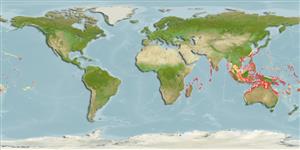Common names from other countries
>
Carangiformes (Jacks) >
Carangidae (Jacks and pompanos) > Caranginae
Etymology: Caranx: French, carangue, the name of a Caribbean fish; 1836 (Ref. 45335).
More on authors: Alleyne & MacLeay.
Environment: milieu / climate zone / depth range / distribution range
Ecologie
marien; brak water rifbewoner; standvastig; diepte 1 - 50 m (Ref. 89972). Tropical; 31°N - 34°S, 26°E - 135°W
Indo-Pacific: Zanzibar, Tanzania and South Africa to Caroline and Marquesan islands, north to the Ryukyu Islands, south to Australia.
Grootte / Gewicht / Leeftijd
Maturity: Lm ? range ? - ? cm
Max length : 88.0 cm TL mannelijk / geslacht onbekend; (Ref. 9710); common length : 55.0 cm FL mannelijk / geslacht onbekend; (Ref. 3287); max. gepubliceerd gewicht: 6.4 kg (Ref. 4699)
Dorsale stekels (totaal): 9; Dorsale zachte stralen (totaal): 21-23; Anale stekels 3; Anale zachte stralen: 16 - 19. Brassy to yellowish green dorsally, shading to silvery on side with scattered dark spots (becoming more numerous with age), conspicuous silvery white spot just behind upper rear edge of opercle, dusky upper caudal fin lobe, and bright yellow to dusky lower lobe with narrow white border (Ref. 90102, Ref. 48635). Body oblong and compressed; dorsal profile moderately convex to second dorsal fin, ventral profile slightly convex. Breast scaleless ventrally, usually with small patch of prepelvic scales. Adipose eyelid weakly developed. (Ref. 90102)
Inhabit lagoon and seaward reefs, occasionally entering rivers. Juveniles found in estuaries. Swims high over bottom (Ref. 48635). Solitary or in schools (Ref. 90102). Feed primarily on fishes. Excellent food fish (Ref. 12484).
Levenscyclus en paargedrag
Maturiteit | Voortplanting | Paaien | Eieren | Fecunditeit | Larven
Oviparous, distinct pairing during breeding (Ref. 205).
Paxton, J.R., D.F. Hoese, G.R. Allen and J.E. Hanley, 1989. Pisces. Petromyzontidae to Carangidae. Zoological Catalogue of Australia, Vol. 7. Australian Government Publishing Service, Canberra, 665 p. (Ref. 7300)
Status op de Rode Lijst van het IUCN (Ref. 130435)
CITES (Ref. 128078)
Not Evaluated
Gevaar voor de mens
Harmless
Gebruik door de mens
Visserij: van minder commercieel belang; Aquacultuur: commercieel; sportvis: ja
Meer informatie
ReferentiesAquacultuurAquacultuurprofielKweeklijnenGeneticaElectrophoresesErfelijkheidZiektesVerwerkingMassaconversie
Tools
Speciale rapporten
Download XML
Internetbronnen
Estimates based on models
Preferred temperature (Ref.
115969): 24.5 - 28.8, mean 27.6 (based on 586 cells).
Fylogenetische diversiteitsindex (Ref.
82804): PD
50 = 0.5000 [Uniqueness, from 0.5 = low to 2.0 = high].
Bayesian length-weight: a=0.01738 (0.01108 - 0.02725), b=2.96 (2.84 - 3.08), in cm Total Length, based on LWR estimates for this species & Genus-body shape (Ref.
93245).
Trofisch niveau (Ref.
69278): 4.0 ±0.5 se; based on diet studies.
Weerstandsvermogen (Ref.
120179): Gemiddeld, minimale populatieverdubbelingstijd 1,4-4,4 jaar (Preliminary K or Fecundity.).
Fishing Vulnerability (Ref.
59153): High vulnerability (55 of 100).
